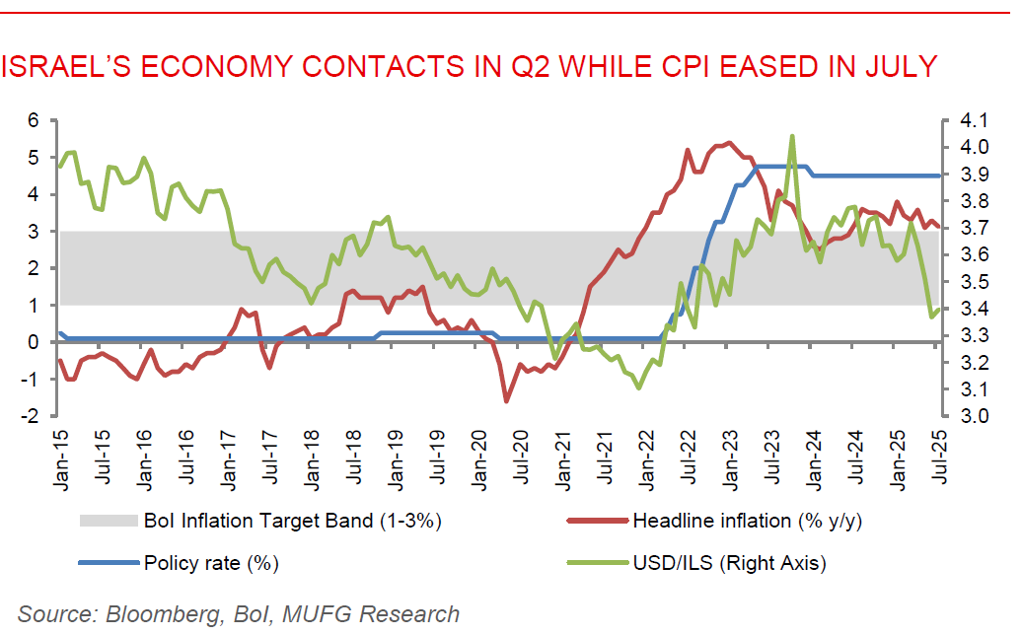To read the full report, please download the PDF above.
Middle East Daily
SOOJIN KIM
Research Analyst
DIFC Branch – Dubai
T: +44(4)387 5031
E: soojin.kim@ae.mufg.jp
MUFG Bank, Ltd. and MUFG Securities plc
A member of MUFG, a global financial group
Middle East Daily
COMMODITIES / ENERGY
Oil prices steady amid uncertainty over Trump’s Zelenskiy peace talks. Oil prices stabilised as traders awaited the outcome of a pivotal meeting between President Trump and Ukrainian President Zelenskiy, where the US is pressuring Ukraine to consider a peace deal with Russia that could involve territorial concessions. Brent crude hovered below USD66/b, and WTI near USD63/b, after a recent 1.5% drop. The Washington summit, also attended by key European leaders, follows Trump’s meeting with Putin in Alaska, where he signalled support for a quick ceasefire and hinted at security guarantees for Ukraine. Oil markets remain volatile, with futures down over 10% this year due to uncertainty from Trump’s trade threats, including tariffs on India for buying Russian crude and a pause on future levies on China. Additionally, OPEC+ supply increases and mixed geopolitical signals have kept oil trading in a narrow range with subdued volume and volatile stabilising.
Gold holds weekly loss as tariff-driven inflation dims rate cut hopes. Gold remained near USD3,340/oz after a 1.8% weekly drop, pressured by signs that President Trump’s tariff policies are fuelling inflation in the US, potentially limiting the scope for Fed rate cuts. A sharp rise in US wholesale inflation in July, the biggest in three years, led traders to scale back expectations for a rate cut next month, with higher borrowing costs weighing on demand for non-yielding assets like gold. While markets still anticipate up to two rate cuts this year, traders are also closely watching geopolitical development, including Trump’s talks with Ukraine’s Zelenskiy, which could impact safe-haven demand. Despite the pullback, gold remains up over 25% YTD, supported by geopolitical tensions, global economic concerns, and diversification away from the US dollar, and is consolidating below its USD3,500 April record high.
MIDDLE EAST - CREDIT TRADING
End of day comment – 18 August 2025. No comments.
MIDDLE EAST - MACRO / MARKETS
Israel’s economy contracts sharply in Q2 amid Iran conflict. Israel’s CPI fell to 3.1% y/y in July from 3.3% y/y in June, but still reflecting persistent inflationary pressures amid ongoing geopolitical tensions and economic strain. The modest decline suggests some stabilisation, yet elevated costs in housing, foods, transportation continue to weigh on consumers, driven by supply chain disruptions and import price pressures following the recent conflict with Iran. Meanwhile, Israel’s economy contracted by 3.5% in Q2 2025, as the brief but intense 12-day war with Iran in June triggered widespread business shutdowns and sharply curtailed economic activity. The contraction was far worse than expected, with the hardest-hit areas being private consumption and gross fixed capital formation. Business sectors GDP fell 6.2%, and GDP per capita dropped 4.4%, its lowest level in a year. The conflict, sparked by Israel’s surprise attack on Iran targeting its nuclear and military infrastructure, led to Iranian missile retaliation and nationwide shelter-in-place conditions. Despite this setback, the central bank still forecasts 3.3% annual growth, while the finance ministry recently downgraded its estimate to 3.1%. achieving those targets will require a strong rebound in H2, even as the government plans a large scale military operation in Gaza, expected to displace one million Palestinians and demand tens of thousands of reserve troops. The Bank of Israel (BoI) faces a delicate balancing act between addressing inflation and supporting a slowing economy.
Lebanon’s credit rating upgrade reflects reform momentum amid persistent risks. S&P global ratings upgraded Lebanon’s long-term local currency sovereign credit rating to ‘CCC’ from ‘CC’ with a stable outlook, reflecting modest improvements in the government’s capacity to service its local currency commercial debt, supported by recurring fiscal surpluses and resumed interest payments to the central bank. The upgrade follows the formation of a new government in early 2025, which has helped revive reform momentum, including the adoption of key legislation such as the amended Banking Secrecy and the Bank Restructuring Law, both essential steps toward unlocking a long-delayed IMF Extended Fund Facility. However, Lebanon remains in selective default (SD) on its foreign currency debt and has yet to pass the critical Financial Gap Law, which is central to determining past banking sector losses and compensating depositors. While the Lebanese pound has stabilised since early 2024 and fiscal performance has improved due to higher revenues and spending controls, the country still faces daunting challenges such as weak institutions, fragile public finances, limited external financing, and ongoing geopolitical tensions with Israel, all of which may delay further reforms. the outlook assumes gradual progress but acknowledges significant downside risks ahead of the May 2026 parliamentary elections.

